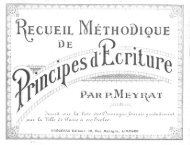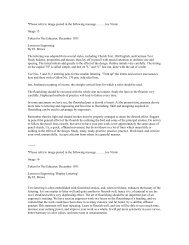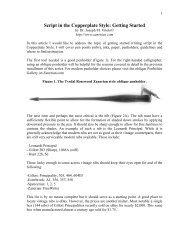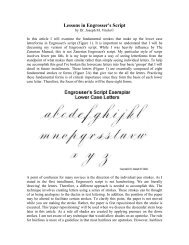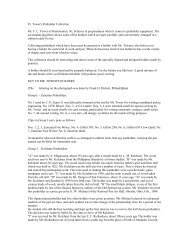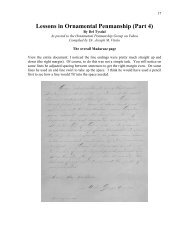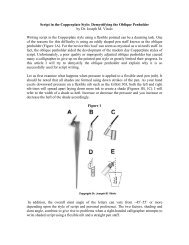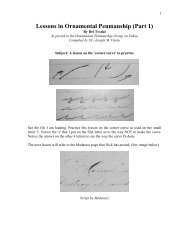The Educator (Volume 45) - IAMPETH
The Educator (Volume 45) - IAMPETH
The Educator (Volume 45) - IAMPETH
Create successful ePaper yourself
Turn your PDF publications into a flip-book with our unique Google optimized e-Paper software.
20<br />
Relation of Eye Health and Efficiency<br />
to Reading and Writing<br />
Once upon a time a principal introduced<br />
into her school a system of<br />
writing founded upon what were<br />
known as elements and principles. A<br />
letter might be formed of first element,<br />
third principles, loop, etc. A<br />
small child laboring most uncomprehendingly<br />
with the intricacies involved,<br />
received such a very poor report<br />
in writing, that the parents tried<br />
to discover the reason for some of the<br />
difficulties. <strong>The</strong> child explained, "I<br />
did try to make the letters like elephants<br />
but the principal was so ugly<br />
that I didn't even want to try to make<br />
any like her." That the child of long<br />
ago is still an exceedingly poor writer<br />
may be due in some respects, at least,<br />
to the confusion arising from an<br />
absolute lack of understanding of<br />
what the hieroglyphics were all about.<br />
It will be recalled that Emmy Lou<br />
experienced similar bewilderment<br />
when, on her first venture into this<br />
unknown world of written expression,<br />
the teacher said, "This is A and this<br />
is a, and this is A and this is a" and<br />
then the music teacher came in and<br />
said "'do' is A," and what is A!!<br />
Present day methods have done<br />
much to do away with most of these<br />
early difficulties but there remains<br />
considerable confusion which it may<br />
be possible, with a little forethought,<br />
to obviate.<br />
At the present time, more attention<br />
is given to remedial reading than at<br />
any other time in this history of education,<br />
with the result that there have<br />
been unearthed more possible causes<br />
for reading disabilities than were ever<br />
thought of in earlier philosophies.<br />
Nor have those whose primary function<br />
it is to instill into youth principles<br />
of good writing been idle; they,<br />
too, have sought for causes of failure<br />
or partial failure and have, in many<br />
instances, found the same or similar<br />
causes underlying these closely akin<br />
subjects.<br />
Life often makes human beings<br />
learn through failure rather than<br />
through success. Thus causes of disease<br />
are usually not sought until the<br />
results of such causes have become<br />
apparent. Likewise in reading and<br />
writing it has been necessary, to some<br />
extent, to work backwards, starting<br />
with the reading failures and trying<br />
to trace the cause. Reading and<br />
writing clinics have been set up with<br />
numerous mechanical devices as aids<br />
to correcting errors and making good<br />
readers and writers out of those who<br />
have failed to measure up. This procedure<br />
has been essential. But it<br />
Winifred Hathaway, Associate Director,<br />
National Society for the Prevention of Blindness<br />
section of the<br />
would be poor economy to keep up<br />
this process indefinitely. When causes<br />
ai-e found, should they not be used<br />
to predict and if possible to prevent<br />
similar failures ?<br />
Some time ago, Garry Myers wrote<br />
a little book, "'<strong>The</strong> Prevention and<br />
Correction of Errors in Arithmetic,"*<br />
presenting the theory that once an<br />
impression is made on the brain, it is<br />
there forever, whether it be right or<br />
wi'ong. Now comes Margaret A.<br />
Stanger and Ellen K. Donohue with<br />
a most readable and understandable<br />
little volume on "Prediction and Prevention<br />
of Reading Difficulties,"**<br />
which presents the same underlying<br />
theory. It has a very definite message<br />
for those interested in these<br />
subjects.<br />
But how is it possible to predict<br />
difficulties in order that prevention<br />
may do away with the agonies of<br />
discouragement and the emotional<br />
upset that so often accompany the<br />
failure to read or to write ? Because<br />
of the complexities of human beings<br />
and the interrelationship of body and<br />
mind through the senses, it is not<br />
always possible to predict, or predicting,<br />
to find adequate preventive measures.<br />
It would seem wise, therefore,<br />
to begin with some predictions that<br />
it is fairly safe to make.<br />
Much has been written about reading<br />
and writing readiness and various<br />
classifications have been presented.<br />
For general discussion it might be<br />
well to make the following simple<br />
grouping: biological (vision, hearing,<br />
general health, etc.), emotional, intellectual,<br />
social. Naturally, there<br />
can be no hard or fast line drawn;<br />
emotional difficulties, for instance,<br />
may result from any one of the other<br />
underlying causes. Since the subject<br />
for discussion is the relation of eye<br />
health and efficiency to reading and<br />
writing, and since reading and writing<br />
are so closely bound up with the<br />
sense of sight, it seems logical to<br />
consider possibilities of prediction<br />
from this viewpoint. As a first prediction,<br />
there may be a general assumption<br />
that if the eyes are so<br />
aft'ected as to be incapable of producing<br />
a clear image on the retina,<br />
the brain will receive an indistinct<br />
picture for interpretation, in all prob-<br />
^"<strong>The</strong> Prevention and Correction of Errors<br />
in Arithmetic,'* Garry Cleveland Myers,<br />
Chicago: Plymouth Press. 1925, 75 pp.<br />
^"Prediction and Prevention of Reading<br />
Difficulties," Margaret A. Stanger and<br />
Ellen K. Donohue. New York: 0.\ford<br />
University Press, 1937, 191 pp.<br />
Cleveland, Ohic<br />
ability resulting in difficulties in reading<br />
and writing for which some preventive<br />
measures may be possible.<br />
To be more specific, it is an established<br />
fact that the eyes of the young<br />
child are normally farsighted; he is<br />
able to see objects at a distance much<br />
better than those close at hand.<br />
Reading and writing difficulties may<br />
be expected if beginning procedures<br />
are heedless of this fact. Hence, in<br />
initiating writing, the reproduction<br />
of a woi'd or a letter or a figure<br />
should be suflSciently large and clear<br />
that the child may see it readily and<br />
comfortably. If such preventive<br />
measures are not carried out the<br />
chances are that the inability to obtain<br />
a clear image without strain may<br />
result in an emotional reaction toward<br />
writing.<br />
If, however, instead of the normal<br />
growth and development of the eye<br />
mentioned above, the child's eyes are<br />
myopic or nearsighted, it may readily<br />
be foreseen that he will desire to<br />
write as small as possible and to<br />
keep the distance between him and<br />
the material on which he is writing<br />
as short as possible. In fact, he may<br />
be found almost touching his nose to<br />
the blackboard, paper or other medium<br />
in order to see the symbols.<br />
<strong>The</strong> initial steps in this case, will,<br />
naturally, be to make every effort to<br />
have the eye difficulty corrected before<br />
reading or writing is initiated.<br />
<strong>The</strong> next step would be to demonstrate<br />
the material in a size that the<br />
child may be able to see at a safe<br />
distance.<br />
What is the prediction in cases of<br />
astigmatism ? Letters and figures will<br />
probably blur or will get out of alignment.<br />
In some types of astigmatism<br />
m and n may look alike, a and o,<br />
8 and 3; in other types, the upright<br />
letters may be confused: h and n;<br />
b and d may be confused with g and<br />
q. Here again, correction of the eye<br />
difficulty is the first step, then distinct<br />
diff'erentiation must be fully and<br />
carefully emphasized and demonstrated<br />
in the letters or figures used.<br />
Muscle imbalance is also an eye<br />
defect for which, if uncorrected, writing<br />
and reading difficulties may be<br />
predicted. A slight imbalance may<br />
cause double vision so that there will<br />
result difficulty in distinguishing between<br />
the real and the imaginary letter.<br />
Whole letters or parts of letters<br />
may appear to run together or to become<br />
indistinct. Here, too, prevention<br />
lies in the correction of the difficulty<br />
not only for the purpose of



